SpaceX has once again demonstrated its prowess in satellite deployment with a pair of successful Falcon 9 launches. These missions, executed from both coasts of the United States, have significantly bolstered the Starlink constellation, with a particular focus on enhancing Direct to Cell capabilities.
SpaceX Starlink Provide Emergency Alerts to All Wireless Users in Cellular Dead Zones
In a display of operational efficiency, SpaceX conducted back-to-back launches from Florida and California. The missions delivered a total of 42 Starlink satellites to low-Earth orbit, marking another milestone in the company’s ambitious satellite internet project.
Of the 42 satellites deployed, 26 are equipped with Direct to Cell technology. This addition brings the total number of Direct to Cell-capable satellites to 168, a substantial increase that promises to revolutionize mobile connectivity.
Ben Longmier, a key figure in SpaceX’s satellite engineering team, highlighted the significance of this deployment, stating that T-Mobile users can expect to see an end to dead zones across the United States later this year. This development represents a major step forward in providing uninterrupted cellular coverage, even in remote areas.
Responding to the announcement, Elon Musk provided additional context on SpaceX’s strategy for Starlink’s Direct to Cell service. For the first year, the service will be exclusive to T-Mobile in the United States. However, Musk indicated that the company plans to expand partnerships with other carriers in subsequent years.
SpaceX’s approach involves initially collaborating with one carrier per country. This strategy likely aims to streamline the rollout process and ensure smooth integration with existing cellular networks. Elon Musk expressed the company’s long-term goal of serving all carriers, suggesting a future where Starlink’s Direct to Cell technology becomes a universal solution for global connectivity.
The rapid expansion of Starlink’s Direct to Cell capabilities has far-reaching implications for global telecommunications. By bridging gaps in cellular coverage, this technology has the potential to connect previously underserved areas, enhancing communication capabilities worldwide.
SpaceX launch and deploy these advanced satellites, the promise of ubiquitous connectivity edges closer to reality. With dead zones potentially becoming a thing of the past, users can look forward to seamless communication experiences, regardless of their location.
In the race to connect the world, SpaceX’s Starlink is certainly shooting for the stars. As these satellites align in orbit, they’re not just linking phones – they’re connecting futures.
Related Post
SpaceX Starlink Introduces ‘Outside Region Fee’ to Combat Unauthorized Starlink Resales
SpaceX Starlink Constellation Nabs FCC Approval for Next-Gen Satellites Upgrades
